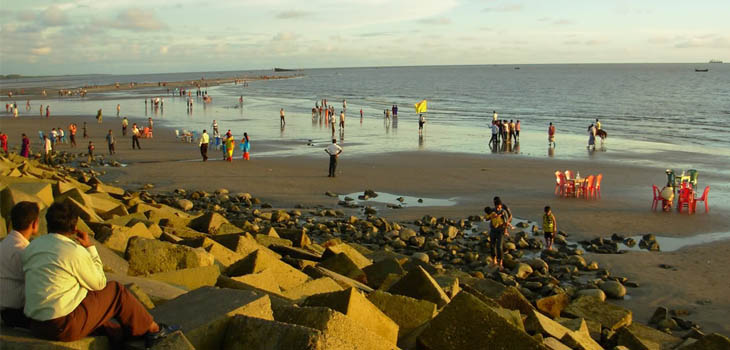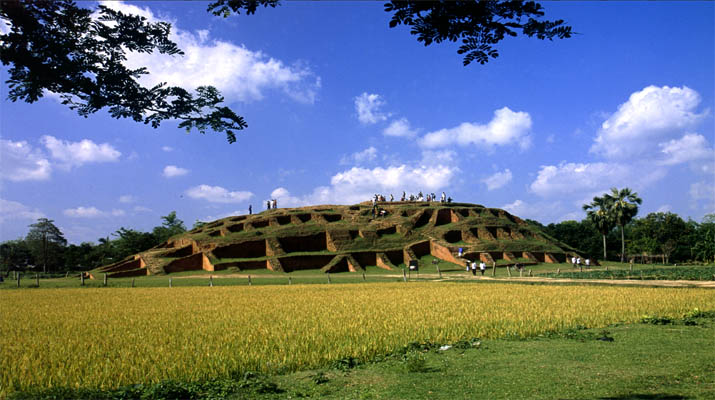- Hits: 13485
- Category: Tourist place
Parki Sea Beach
The beach lies 16-17 km away from Chittagong city and surrounding by Zhau forest. Parki beach might be the next tourist attraction of Bangladesh, which is situated in Anwara thana under southern Chittagong region.As the beach is situated at the Karnafuli river channel, visitors can view both the Karnafuli river and the sea together. Tourists enjoy the views of big ships anchored at the outer dock, fishermen catching fish in sea, sunset, various colored crabs at the beach and quiet environment.
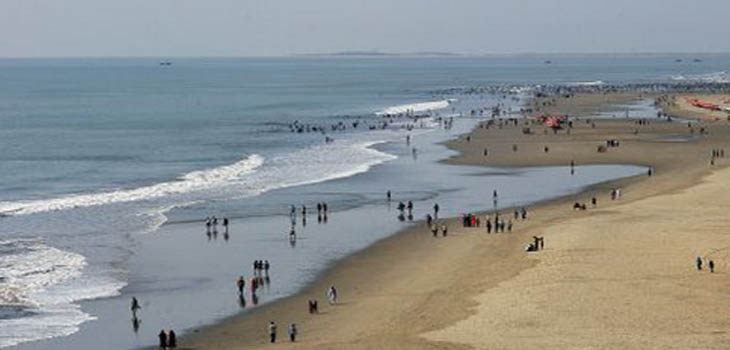
- Hits: 12655
- Category: Tourist place
Patenga Beach
Patenga is a popular tourist spot. The beach is very close to the Bangladesh Naval Academy of the Bangladesh Navy and Shah Amanat International Airport. Its width is narrow and swimming in the seas is not recommended. Part of the seashore is built-up with concrete walls, and large blocks of stones have been laid to prevent erosion. During the 1990s, a host of restaurants and kiosks sprouted out around the beach area. Lighting of the area has enhanced the security aspect of visiting at night.Nowadays, alcohol peddling is very common at the beach. Vendors from the city sell their ice creams, cold drinks and food to the hundreds of tourists who come to Patenga Beach. According to the local people, Patenga is the best place for delicious, mouth-watering street food at very low costs. One of the popular dishes of the food stands is the fried, spicy mud crab served with a small plate full of falafel, garnished with cucumber and onion. The beach has a wonderful cool atmosphere even at the evening, and people come to enjoy the soothing breeze. The beach is lined with massive shady palm trees and fishing boats. It also has an array of speed boats for visitors. The beach, however, is quite sandy, with a few rocky patches.Most visitors come to Patenga Beach as it is known for having some of the most stunning sunsets and sunrises in Bangladesh.
- Hits: 13264
- Category: Tourist place
Kantajew Temple
This Temple near Dinajpur town was built in 1752 by Maharaja Pran Nath of Dinajpur. The temple, a 50' square three-storeyed edifice, rests on a slightly curved raised plinth of sandstone blocks, believed to have been quarried from the ruins of the ancient city of Bangarh near Gangarampur in West Bengal from where the now stolen Radha-Krishna idols are said to have been brought. It was originally a nava-ratna temple, crowned with four richly ornamental corner towers on two storeys and a central one over the third storey. Unfortunately these ornate towers collapsed during an earthquake at the end of the 19th century.Every inch of the temple surface is beautifully embellished with exquisite terracotta plaques, representing flora, fauna, geometric motifs, mythological scenes and an astonishing array of contemporary social scenes and favourite pastimes. The Maharaja's palace with relics of the past centuries and local museum are worth a visit.
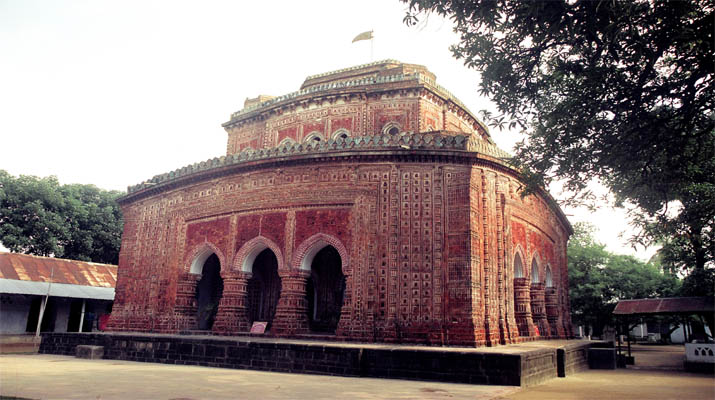
- Hits: 16300
- Category: Tourist place
Sixty Dome Mosque
The Sixty Dome Mosque (more commonly known as Shait Gambuj Mosque or Saith Gunbad Masjid),a UNESCO World Heritage Site, is a mosque in Bangladesh, the largest in that country from the Sultanate period. It has been described as "the most impressive Muslim monuments in the whole of the Indian subcontinent.In mid-15th century, a Muslim colony was founded in the unfriendly mangrove forest of the Sundarbans near the coastline in the Bagerhat district by an obscure saint-General, named Khan Jahan Ali. He preached in an affluent city during the reign of Sultan Nasiruddin Mahmud Shah, then known as 'Khalifalabad'. Khan Jahan adorned this city with more than a dozen mosques, the spectacular ruins of which are focused around the most imposing and largest multidomed mosques in Bangladesh, known as the Shait-Gumbad Masjid (160'×108'). The construction of the mosque was started in 1442 and it was completed in 1459.The mosque was used for prayer purposes. It was also used as a madrasha and assembly hall.It is located in Bagerhat district in southern Bangladesh which is in the division of Khulna. It is about 3 miles far from the main town of Bagerhat. Bagerhat is nearly 200 miles away from Dhaka which is the capital of Bangladesh.The 'Sixty Dome' Mosque has walls of unusually thick, tapered brick in the Tughlaq style and a hut-shaped roofline that anticipates later styles. The length of the mosque is 160 feet and width is 108 feet. There are 77 low domes arranged in seven rows of eleven, and one dome on each corner, bringing the total to 81 domes. There are four towers. Two of four towers were used to call azaan. The interior is divided into many aisles and bays by slender columns, which culminate in numerous arches that support the roof.The mosque has 77 squat domes with 7 four-sided pitched Bengali domes in the middle row.The vast prayer hall, although provided with 11 arched doorways on east and 7 each on north and south for ventilation and light, presents a dark and somber appearance inside. It is divided into 7 longitudinal aisles and 11 deep bays by a forest of 60 slender stone columns, from which springs rows of endless arches, supporting the domes. Six feet thick, slightly tapering walls and hollow and round, almost detached corner towers, resembling the bastions of fortress, each capped by small rounded cupolas, recall the Tughlaq architecture of Delhi.The mosque represents wonderful archeological beauty which was the signature in the 15th century.The mosque is locally known as the 'Shat Gombuj Masjid', which in Bangla means Sixty Domed Mosque. However, there are 77 domes over the main hall and exactly 60 stone pillars. It is possible that the mosque was originally referred to as the Sixty Pillared Mosque where Amud (شصت عمؤد ) meaning column in Arabic/Persian, later got corrupted to Gombuj (গম্বুজ) in Bangla, which means domes.
Sixty Dome Mosque
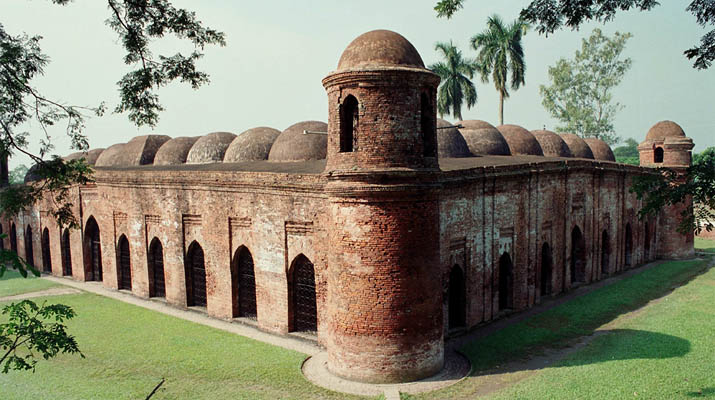
- Hits: 12683
- Category: Tourist place
Mahasthangarh
Mahasthangarh is one of the earliest urban archaeological sites so far discovered in Bangladesh. The village Mahasthan in Shibganj thana of Bogra District contains the remains of an ancient city which was called Pundranagara or Paundravardhanapura in the territory of Pundravardhana. A limestone slab bearing six lines in Prakrit in Brahmi script, discovered in 1931, dates Mahasthangarh to at least the 3rd century BC. The fortified area was in use till the 18th century AD.Together with the ancient and medieval ruins, the mazhar (holy tomb) of Shah Sultan Balkhi Mahisawar built at the site of a Hindu temple is located at Mahasthangarh. He was a dervish (holy person devoted to Islam) of royal lineage who came to the Mahasthangarh area, with the objective of spreading Islam among non-Muslims. He converted the people of the area to Islam and settled there.Mahasthan means a place that has excellent sanctity and garh means fort. Mahasthan was first mentioned in a Sanskrit text of the 13th century entitledVallalcharita. It is also mentioned in an anonymous text Karatoya mahatmya,circumstantially placed in 12th–13th century. The same text also mentions two more names to mean the same place – Pundrakshetra, land of the Pundras, and Pundranagara, city of the Pundras. In 1685, an administrative decree mentioned the place as Mastangarh, a mixture of Sanskrit and Persian meaning fortified place of an auspicious personage. Subsequent discoveries have confirmed that the earlier name was Pundranagara or Paundravardhanapura, and that the present name of Mahasthangarh is of later origin.Mahasthangarh is a notable historical tourist attraction of Bangladesh. Many tourists come here to see the glory of Mahasthangarh.
Mahasthangarh



